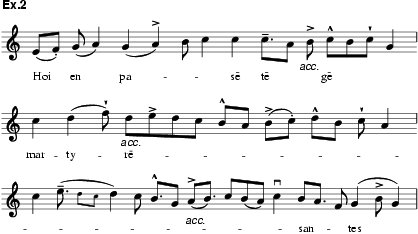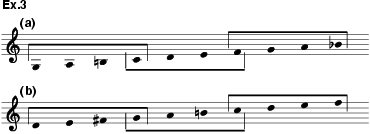
(Gk.: ‘scroll’).
A liturgical poem sung mainly at Orthrosin the Byzantine rite. One of the two most important poetic forms in medieval Byzantine religious poetry (the other being the kanōn), the kontakion most likely originated in Byzantium, although a strong Syrian influence is evident, particularly the poetry of Ephrem Syrus(cf Petersen, 1985). It is a kind of poetic homily whose narrative and dramatic content greatly influenced later Byzantine poetry. According to legend, the Blessed Virgin Mary gave to Romanos the Melodist, a notable 6th-century hymn writer and composer, a scroll on which he wrote, by divine inspiration, a Christmas kontakion, Hē parthenos sēmeron (‘Today the Virgin’).
Introduced into the Byzantine Hours during the 6th century, the kontakion was originally part of the Constantinopolitan ‘cathedral’ vigil that later came to be incorporated into Orthros (see Lingas). In its full form it consisted of an initial strophe – the prooimion or koukoulion – followed by some 18 to 30 strophes – the oikoi – whose common metrical structure was different from that of the prooimion. Each kontakion was recited in a simple manner (for ease of understanding), and the people responded with the prooimion and oikoi refrain, which underlined the main theme of the hymn. When in the 9th and 10th centuries monastic Orthros began to fuse with the cathedral Office, the full performance of the kontakion became optional. It was eventually reduced to the prooimion and first oikos alone and sung immediately after the 6th ode of the Kanōn. The melodies of the two remaining strophes were often subject to melismatic elaboration and became the showpiece of the psaltēs (soloist).
The classical collection of kontakion melodies covers the whole of the church year. Two melodic traditions are preserved in the various psaltikon manuscripts: an older, ‘short’ form (also referred to as ‘psaltikon I’) and a more recent, ‘long’ form (‘psaltikon II’); they differ from each other to a greater extent than the shorter and longer traditions of the allēlouïarion (see Alleluia, §II) and the Prokeimenon. The first two lines of the prooimion of the Christmas kontakion Hē parthenos sēmeron illustrate the ‘short’ kontakion tradition (see ex.1, taken from the 13th-century manuscript I-Rvat Ashb. 64). In general, however, this festival hymn is not typical of the kontakion style but is more akin to the celebrated Akathistos Hymn (the kontakion of the Annunciation of the Virgin Mary). Many manuscripts give all the oikoi of the Akathistos with neumes, and the performance of this highly elaborate hymn must have lasted at least an hour.

In addition to the psaltikon transmission, there exists in manuscripts dating from the 13th century onwards a collection of syllabic kontakia melodies that were used for model stanzas (automela) for many troparia (see Troparion). The relationship between the syllabic tradition and the two embellished, melismatic, psaltikon traditions is yet to be fully studied (see Raasted, 1989).
With regard to melodic structure, both kontakia and allēlouïaria use very similar material, especially the initial motifs and cadences. This shows either that kontakia depended on the allēlouïarion tradition or that the two types developed from the same simple text recitation. Analysis of the kontakion melodies makes it possible to identify certain formulae that tend to occur in the same sequence, thus establishing ‘melody types’. The prooimion and the oikos are structurally similar: both are divided into lines that correspond to a restricted number of melody types. The common kontakion tradition may be exemplified by the kontakion of All Saints for the Sunday after Pentecost (the first line of the oikos is given in ex.2).

Although the melodic formulae are shared among the eight modes, there are very few melodies in the 1st and 3rd modes, and with the exception of the Christmas kontakion in the 3rd mode (see ex.1), the melodies are without any character of their own. There is not, in fact, sufficient melodic material among the kontakion melodies for eight modes. The tonal system tends to be one of conjunct tetrachords, taking the form of either a ‘low’ (ex.3a) or a ‘high’ system (ex.3b). This system is apparent both from an analysis of formulae and cadences that have the same interval structure but are pitched a 4th apart, and also from an analysis of the ‘wrong’ medial signatures (i.e. signatures that seem to indicate an abnormal pitch; see Byzantine chant, §3(ii)).

While the psaltikon is the melody book of the psaltēs, containing principally kontakia, the asmatikon is the choirbook of a psaltēs group. In many cases the psaltikon manuscripts include part of the asmatikon repertory (a completely different style from the kontakion). The Byzantine sources reveal that part of the psaltikon repertory, the hypakoai, also occurs in an asmatikon version. Furthermore, the Slavonic manuscripts from the same period as the Byzantine sources give asmatikon counterparts of the kontakia. Only the prooimia are delivered in this choral recension – possibly a relic of a practice by which the psaltēs choir sang the prooimion while one psaltēs performed the oikoi. The notation of the Slavonic manuscripts remains problematic. At any rate the kontakion melodies of this tradition seem to be less melismatic.
C. Høeg, ed.: Contacarium ashburnhamense, MMB, Principale, iv (1956) [incl. important introduction, 11ff]
E. Wellesz: The Akathistos Hymn, MMB, Transcripta, ix (1957)
A. Bugge, ed.: Contacarium palaeoslavicum mosquense, MMB, Principale, vi (1960)
F. Constantin: ‘Das Kontakion’, Deutsche Vierteljahrschrift für Literaturwissenschaft und Geistesgeschichte, xxiv (1960), 84–106
C. Thodberg: The Tonal System of the Kontakarium: Studies in Byzantine Psaltikon Style (Copenhagen, 1960)
K. Levy: ‘An Early Chant for Romanus’ “Contacium trium puerorum”’, Classica et mediaevalia, xxii (1961), 172–5
K. Levy: ‘A Hymn for Thursday in Holy Week’, JAMS, xvi (1963), 127–75
H.Husmann: ‘Modalitätsprobleme des psaltischen Stils’, AMw, xxvii (1971), 43–72
C. Thodberg: ‘The Discussion of the Psaltikon Tonality’, IMSCR XI: Copenhagen 1972, 786–90
J. Raasted: ‘Zur Melodie des Kontakions “Hē parthenos sēmeron”’,Musica antiqua VI: Bydgoszcz 1982, 191–204; repr. in Cahiers de l’Institut du Moyen Age grec et latin, lix (1989), 233–46
A. Şirli: ‘The Akathistos Hymn in the Greek and Romanian Manuscripts of the 14th–18th Centuries’, Musica antiqua VI: Bydgoszcz 1982, 565–79
W.L. Petersen: The Diatesseron and Ephrem Syrus as Sources of Romanos the Melodist (Leuven,1985)
A. Lingas: ‘The Liturgical Place of the Kontakion in Constantinople’, Liturgiya, arkhitektura i iskusstvo vizantiyskogo mira: Moscow 1991 [Liturgy, architecture and art of the Byzantine world], ed. K.K. Akent'yev, i (St Petersburg, 1995), 50–57
CHRISTIAN THODBERG/R